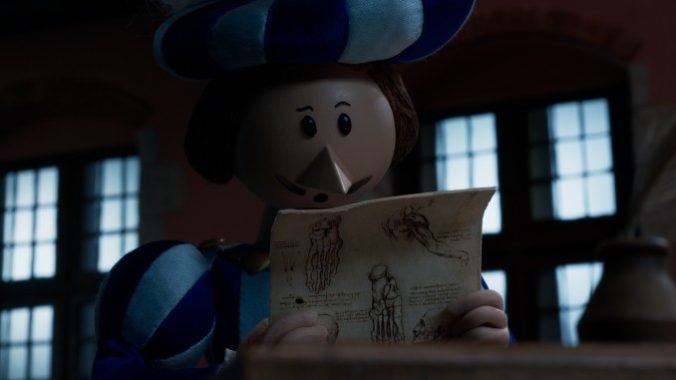The Soul of Leonardo da Vinci is Captured in The Inventor

What a delight it is to be reminded that the creative endeavors of artists living today can reconnect us so exquisitely to both the vitality and frustrations of an artist who lived 500 years ago. Director Jim Capobianco and co-director Pierre-Luc Granjon do just that with The Inventor, their gorgeously rendered hand-drawn and stop-motion animated interpretation of the last years of Leonardo da Vinci.
One of the smartest things that The Inventor does in its presentation of da Vinci’s life, which makes it accessible for both young and older viewers, is constraining its storytelling scope. The tight 90-minute runtime doesn’t attempt to compress the depth and breadth of da Vinci’s prolific life of creation and invention into a typical biopic. Instead, Capobianco’s script wisely focuses on the last four years of his life.
Residing in Rome under the papacy of Pope Leo X (Matt Berry), da Vinci (Stephen Fry)—like all artists of his time—operates like a kept man. Long dependent on the patronage of wealthy donors like Giuliano de Medici (John Gilkey) to fund his art and inventions, da Vinci is still a vigorous creator. But he is beyond weary with the oppression of the Catholic Church regarding some of his more radical ideas, like the search for the soul via the dissection of cadavers. Berry is well cast as the perpetually befuddled Pope, blustering vehemently against da Vinci’s fringe pursuits, calling them blasphemous and threatening him with excommunication. However, a visit by the younger King of France, Francis the First (Gauthier Battoue), presents da Vinci with a more open-minded advocate for his ideas. In 1516, Francis invites da Vinci and his two loyal assistants, Francesco Melzi (Angelino Sandri) and the hulking but silent Zoroastro, to his royal court to create for France, and da Vinci’s final creative chapter begins.
Leonardo da Vinci’s time in France is portrayed as both prolific yet limited. He comes up with revolutionary ideas for urban planning, like his concept of the Ideal City, which is depicted via daVinci’s actual sketches. Yet he continues to be hampered by the small-minded men who fund him, along with the increasing failures of his own body. The film invents for him a challenging muse and friend in Princess Marguerite de Navarre (Daisy Ridley), the enlightened sister of King Francis. Also a free-thinker, she is just as enamored with da Vinci’s ideas, especially the Ideal City, and takes over its construction when her preoccupied brother and mother, Louise de Savoy (Marion Cotillard), are focused on more ego-centric pursuits.
Pulled in too many creative directions, da Vinci finds it harder to find the patience or energy to focus on anything outside of his existential pursuits. He laments the frivolity of the King wanting him to make showy baubles, vanity statues or machines to facilitate advantages in impending wars. He is not what da Vinci had hoped for as a patron. Instead, his collaborations with the empathetic and curious Marguerite are where he finds true inspiration. And it is through her that da Vinci eventually comes to his own enlightenment about what the soul represents.
-

-

-

-

-

-

-

-

-

-

-

-

-

-

-

-

-

-

-

-

-

-

-

-

-

-

-

-

-

-

-

-

-

-

-

-

-

-

-

-








































